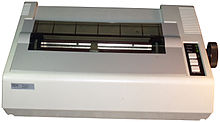Epson MX-80
The MX-80 was a massive commercial success for Epson and soon became the best-selling dot matrix printer in the world, selling well over one million units over the course of its market lifespan.
The form factor and basic functionality of the MX-80 soon became a de facto standard for manufacturers of inexpensive dot matrix printers.
During development, the company pioneered a number of features, such as logical bidirectional printing to maximize throughput; and disposable printheads.
[3]: 10 The MX-80 also detects special escape characters as part of its printer control language, allowing the printhead to be tabbed over to specific areas on the page, useful for automated form filling.
[4] While textual characters are normally laid out in a 6 by 9 dot grid, the printer's ROM can have the printhead impact the paper in half-steps horizontally, allowing for slightly smoother letterforms.
[4] The printhead is good for roughly 50 million character impressions; after its end-of-life, it can be disposed of and replaced by the user without needing tools.
[7]: 6 [8] The MX series of printers was retired in the mid-1980s, after Epson released its successor the FX-80 in 1983, featuring a wider platen, a faster printhead, a larger data buffer, user-definable character sets for custom symbols and typefaces, and more.
[3]: 28–30 The MX-80 was an immediate critical and commercial success for Epson, the company selling tens of thousands of units within two months of its introduction.
[3]: 5 The MX-80 was widely cloned by other manufacturers,[3]: 5 with its form factor and functionality quickly becoming a de facto standard for nearly all dot matrix printers that followed it.
This PCL was eventually codified in the early 1980s by Epson as ESC/P and received a number of updates over the years, increasing its feature set.


